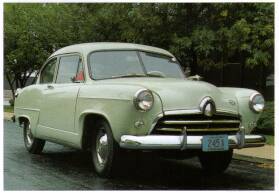The Lightning was a Willys straight-6 engine produced in the 1940s and 1950s. It was used in the Willys Jeep Station Wagon and other Jeep-based vehicles at the time. It was replaced with the Willys Super Hurricane engine.
The Lightning was a Willys straight-6 engine produced in the 1940s and 1950s. It was used in the Willys Jeep Station Wagon and other Jeep-based vehicles at the time. It was replaced with the Willys Super Hurricane engine.
The L148 version displaced 148 in³ (2.4 L).
Applications:
The L161 version displaced 161 in³ (2.6 L).
Applications:

Jeep is an American automobile marque, now owned by multi-national corporation Stellantis. Jeep has been part of Chrysler since 1987, when Chrysler acquired the Jeep brand, along with remaining assets, from its previous owner American Motors Corporation (AMC).

Kaiser Motors Corporation made automobiles at Willow Run, Michigan, United States, from 1945 to 1953. In 1953, Kaiser merged with Willys-Overland to form Willys Motors Incorporated, moving its production operations to the Willys plant at Toledo, Ohio where they continued to build automobiles under the Kaiser marque including the Kaiser Darrin until 1955. Their South American operations continued to build passenger cars well up into the 1960s. The company changed its name to Kaiser Jeep Corporation in 1963.

The Jeep CJ models are a series and a range of small, open-bodied off-road vehicles and compact pickup trucks, built and sold by several successive incarnations of the Jeep automobile marque from 1945 to 1986. The 1945 Willys Jeep was the world's first mass-produced civilian four-wheel drive car.

The Willys F4-134 Hurricane was an inline-4 piston engine and powered the famous Jeep CJ in the CJ-3B, CJ-5, and CJ-6 models. It was also used in the Willys 473 and 475 pickups, wagons, and sedan deliveries. It replaced the Willys Go Devil engine that was used in the MB Jeep and other early Jeep-based models like the Jeepster. This engine was also built by Mitsubishi for their license-built Jeep, as well as other applications.

The Jeep Wagoneer is a luxury 4x4 produced and marketed under Jeep under successive automakers from 1962 to 1991. Described when it was introduced as a station wagon body style, the innovative concept by industrial designer Brooks Stevens over time pioneered the luxury "sport utility vehicle" (SUV).

The Willys Jeep Truck is a truck made by Willys-Overland Motors from 1947 to 1965. The styling and engineering of the Jeep Truck was based on Willys' existing vehicles, the Willys Jeep Station Wagon and the Jeep CJ-2A.

Kaiser Jeep was the result of the 1953 merger of Kaiser Motors, an independent passenger car maker based in Willow Run, Michigan, with the Toledo, Ohio-based Willys-Overland Company.

The Jeepster Commando is an automobile which was first produced by Kaiser Jeep in 1966 to compete with the International Scout, Toyota Land Cruiser and Ford Bronco. Four different models were available: a pickup truck, convertible, roadster and wagon. The Jeepster remained in production after American Motors Corporation (AMC) bought the Jeep line from Kaiser in 1970. After AMC's acquisition, the Jeepster Commando C101 steadily grew in popularity. In 1972, AMC shortened the vehicle's name to Commando C104, extended the wheelbase to 104", and changed the front-end design to accept the AMC I6 and V8 304ci, similar to the Ford Bronco. The new configuration, formerly an AMC best seller, quickly caused the line to drop in popularity and was taken out of production in 1973; it was replaced with the full size Cherokee. The Jeepster is an ancestor of the modern Jeep family produced by Chrysler.

The Jeepster is an automobile originally produced by Willys-Overland Motors from 1948 to 1950. It was developed to fill a gap in the company's product line, crossing over from their "utilitarian" proto SUVs and trucks to the passenger automobile market.
The Kaiser-Frazer Corporation was the result of a partnership between industrialist Henry J. Kaiser and automobile executive Joseph W. Frazer. In 1947, the company acquired the automotive assets of Graham-Paige, of which Frazer had become president near the end of World War II. Kaiser-Frazer was one of a few US automakers to achieve success after World War II, if only for a few years. Joseph W. Frazer left the company in 1949, replaced as president by Henry's son Edgar F. Kaiser.

The Willys L134 is a straight-4 automobile engine that was made famous in the Willys MB and Ford GPW Jeep produced during World War II. It powered nearly all the Jeep vehicles built for the U.S. and Allies. It was later used in a variety of civilian Jeep vehicles.
The Willys Aero was a line of passenger cars manufactured first by Willys-Overland and later by Kaiser-Willys Corporation from 1952 through 1955. It was also produced in Brazil from 1960 to 1971.
The Borg-Warner T-90 is a three-speed manual gearbox manufactured by Borg-Warner. It was used in most Willys and Kaiser-Jeep models from 1945 to 1971, as well as a number of International Harvester models. It is an improved version of the T-84 used in WWII Willys MB and Ford GPW military Jeeps. It was constructed with an iron case in both top-shift and side-shift variants. The gears are spur cut with only 2nd and 3rd gears synchronized.

The Willys MB and the Ford GPW, both formally called the U.S. Army Truck, 1⁄4-ton, 4×4, Command Reconnaissance, commonly known as the Willys Jeep, Jeep, or jeep, and sometimes referred to by its supply catalogue designation G503, were highly successful American off-road capable light military utility vehicles, built in large numbers to a single standardized design, for the United States and the Allied forces in World War II from 1941 until 1945.

The Willys Jeep Station Wagon, Jeep Utility Wagon and Jeep Panel Delivery are automobiles produced by Willys and Kaiser Jeep in the United States from 1946 to 1964, with production in Argentina and Brazil continuing until 1970 and 1977 respectively. They were the first mass-market all-steel station wagons designed and built as a passenger vehicle.
Vehicles made by American Motors Corporation (AMC) and Jeep incorporated a variety of transmissions and transfer case systems. This article covers transmissions used in the following vehicle models and years:
Delmar Gerle "Barney" Roos was an American automotive engineer who served as Studebaker's head of engineering from 1926 to 1936, specialising in straight-eight engines. He later worked for the British Rootes Group in the design of Humber, Hillman and Sunbeam Talbot cars. Before World War II, he returned to the United States, where he co-designed the Willys MB, the original Jeep.

The Willys Americar was a line of automobiles produced by Willys-Overland Motors from 1937 to 1942, either as a sedan, coupe, station wagon or pickup truck. The coupe version is a very popular hot rod choice, either as a donor car or as a fiberglass model.

Willys was a brand name used by Willys–Overland Motors, an American automobile company, founded by John North Willys. It was best known for its design and production of World War II era and later military jeeps (MBs), as well as civilian versions, and branding the 'jeep' military slang-word into the '(Universal) Jeep' marque.